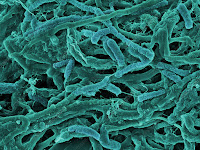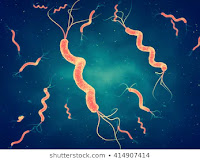KINGDOM MONERA
The term
Monera is came from the Greek word "moneres" which means
"single or solitary". This Kingdom consists of unicellular
prokaryotic organisms. The Monera was first considered as phylum by Ernst
Haeckel in 1866. Later it was changed to kingdom by Edouard Chatton. it is
observed in four kingdom, five kingdom, three domain system classification
by Herbert F Copeland, R.H. Whitaker and Carl Woese respectively. This kingdom
includes Archaebacteria, Eubacteria, Actinomycetes, Mycoplasma, and Spirochetes
etc. These lack nuclear envelope and unit membrane bound organelles which are
unique features in them.
Archaebacteria:
bb Also known as Archaea. These are highly
diverse with respect to morphology, reproduction, physiology and ecology.They
can be gram positive or Gram negative. They may be in rod shaped, spherical
shaped, spiral and other. Archaebacteria shows similarity with eubacteria in characteristics
like cellular size, absence of nucleus, histones, circular organisation of their
genomes, presence of 70S ribosomes, spliceosomal introns, organisation of genes
into operons etc. and also metabolic pathways. They re different from eubacteria
in information processes such as DNA replication, transcription and
translation. However, Archaebacteria are more related to Eukarya than
eubacteria in phylogeny.
Also known as Archaea. These are highly
diverse with respect to morphology, reproduction, physiology and ecology.They
can be gram positive or Gram negative. They may be in rod shaped, spherical
shaped, spiral and other. Archaebacteria shows similarity with eubacteria in characteristics
like cellular size, absence of nucleus, histones, circular organisation of their
genomes, presence of 70S ribosomes, spliceosomal introns, organisation of genes
into operons etc. and also metabolic pathways. They re different from eubacteria
in information processes such as DNA replication, transcription and
translation. However, Archaebacteria are more related to Eukarya than
eubacteria in phylogeny.
 Also known as Archaea. These are highly
diverse with respect to morphology, reproduction, physiology and ecology.They
can be gram positive or Gram negative. They may be in rod shaped, spherical
shaped, spiral and other. Archaebacteria shows similarity with eubacteria in characteristics
like cellular size, absence of nucleus, histones, circular organisation of their
genomes, presence of 70S ribosomes, spliceosomal introns, organisation of genes
into operons etc. and also metabolic pathways. They re different from eubacteria
in information processes such as DNA replication, transcription and
translation. However, Archaebacteria are more related to Eukarya than
eubacteria in phylogeny.
Also known as Archaea. These are highly
diverse with respect to morphology, reproduction, physiology and ecology.They
can be gram positive or Gram negative. They may be in rod shaped, spherical
shaped, spiral and other. Archaebacteria shows similarity with eubacteria in characteristics
like cellular size, absence of nucleus, histones, circular organisation of their
genomes, presence of 70S ribosomes, spliceosomal introns, organisation of genes
into operons etc. and also metabolic pathways. They re different from eubacteria
in information processes such as DNA replication, transcription and
translation. However, Archaebacteria are more related to Eukarya than
eubacteria in phylogeny.
Archaea are first
identified bacterial cells. The cell wall composition of Archaebacteria are
different from eubacteria. This contains different cell wall composition. Their
cell wall is made up of polysaccharides, glycoproteins or proteins, with no peptidoglycan.
Their cell wall made up of polysaccharide Pseudomurein. Pseudomurein is a
modified peptidoglycan without D-Amino acids and contains
N-acetyltalosaminuronic acid instead of N-acetyl muramic acid which is found in
methanogens. All archaea are resistant to lysozyme and beat lactam antibiotics and penicillin.
Major groups of Archaea:-
·
Methanogens
·
Extreme halophiles
·
Thermophiles
These are
methane producing obligate anaerobic. Largest group of archaea found in this
group.
Extreme halophiles:
Halophile
sea with salt survivors
These are
survive in very high salt concentrations. Example: Halobacterium salinarium, these
can carry out photosynthesis without chlorophyll or
bacteriochlorophyll by using bacteriorhodopsin. These are Chemorganoheterotrophs.
Philip means loving; these
are heat loving agents found near hydrothermal vents and hot springs. The
optimum growth temperature is between 70-110°C. They are Gram negative and
strict anaerobes.These are extremophiles i.e., they can survive under harsh
habitats.
Survival zone
|
Called as
|
Examples
|
High salt conditions
|
Halophiles
|
Halobacteriaceae
|
Hot springs
|
Thermoacidophiles
|
Thermos aquaticus
|
Marshy areas
|
Methanogens
|
methanococcus
|
Also called as bacteria. These
are the true bacteria (Eu: true) which are unicellular prokaryotic microscopic
microorganisms. They vary in shapes. The main shapes we observe in bacteria are
spherical, rod, comma, spiral shapes etc. The bacteria were named based on
their shapes,
Cocci: These are spherical
or round or oval in shape. (Singular: Coccus).
Based on their arrangement
cocci are classified as:
·
Monococcus: Presence
of single cocci.
·
Diplococcus:
Presence of two cocci.
·
Tetrad:Group
of four cocci.
·
Staphylococcus: Group
of cluster of cocci.
·
Sarcina: Group of eight
cocci.

2.
Bacillus: The
bacteria which are in rod shape are called bacillus. (Plural: bacilli). These
are also classified and named based on their arrangement.
·
Coccobacillus: bacillus is
oval and round similar to coccus
3.
Vibro: bacteria
are in coma shape.
4.
Spirillum: bacteria
are spiral shape.
The Eubacteria has rigid
cell wall made up of Peptidoglycan also called murein or mucopeptide. The
genetic material is naked which is not enveloped by nuclear membrane as in all
prokaryotes. Cell organelles are absent in all prokaryotes. Ribosomes are
present.
When it comes to feed, the
bacteria are almost heterotrophy and saprophytic, but few are autotrophy which may
be photosynthetic autotrophy or chemosynthetic autotrophy.
Examples of Bacterial species
Differences
between Eubacteria and Archaebacteria:
Property
|
Eubacteria
|
Archaebacteria
|
Nucleus
|
Absent
|
Absent
|
Unit
membrane bound organelles
|
Absent
|
Absent
|
Cell
wall
|
Peptidoglycan containing muramic acid
|
Variety of types; no muramic acid
|
Membrane
lipid
|
Have ester linked, straight-chained fatty acid.
|
Have ether linked, branched aliphatic chains.
|
Cyanobacteria:
 These
are also known as Blue-green algae. These are the most primitive organisms
showing oxygenic photosynthesis and these are obligate photolithoautotrophs. Few
cyanobacteria are nitrogen fixers which can fix atmospheric nitrogen in
specialised cells called heterocysts. These are unicellular colonial or
filamentous forms may be branched or unbranched. These are Gram negative
bacteria. Their cell wall is made up of peptidoglycan. Photosynthetic pigments present in
cyanobacteria are Chl a (but in very few cases Chl b and Chl d also present),
carotenoids and phycobilins (phycocyanin and phycoerythrin). The protoplasm of
cyanobacterial cell is differentiated into a central colourlesscentroplasmwith
chromatin material and peripheral chromoplasm. They often form blooms in
polluted water bodies. Their colonies, filaments are surrounded by gelatinous sheath.
All cyanobacteria contain thylakoid membranes in which light reactions of
photosynthesis and respirations occur. But the genus Gloeobacterwhich is sister group of all cyanobacteria lack
thylakoid membranes. Instead they contain ‘Phycobilisomes’ which are light
harvesting complexes. Hence, unlike cyanobateria photosynthesis process occurs
in plasma membrane instead in thylakoids in these organisms.
These
are also known as Blue-green algae. These are the most primitive organisms
showing oxygenic photosynthesis and these are obligate photolithoautotrophs. Few
cyanobacteria are nitrogen fixers which can fix atmospheric nitrogen in
specialised cells called heterocysts. These are unicellular colonial or
filamentous forms may be branched or unbranched. These are Gram negative
bacteria. Their cell wall is made up of peptidoglycan. Photosynthetic pigments present in
cyanobacteria are Chl a (but in very few cases Chl b and Chl d also present),
carotenoids and phycobilins (phycocyanin and phycoerythrin). The protoplasm of
cyanobacterial cell is differentiated into a central colourlesscentroplasmwith
chromatin material and peripheral chromoplasm. They often form blooms in
polluted water bodies. Their colonies, filaments are surrounded by gelatinous sheath.
All cyanobacteria contain thylakoid membranes in which light reactions of
photosynthesis and respirations occur. But the genus Gloeobacterwhich is sister group of all cyanobacteria lack
thylakoid membranes. Instead they contain ‘Phycobilisomes’ which are light
harvesting complexes. Hence, unlike cyanobateria photosynthesis process occurs
in plasma membrane instead in thylakoids in these organisms.
The reproduction in cyanobacteria occurs by
binary fission, budding, and multiple fission.These produce akinetes
under unfavourable condition which protects them during adverse periods. The
akinetes are covered with thick walls and appear more in size than vegetative
cells. The filamentous cyanobacteria are fragmented into short pieces during
fragmentation which are called Harmogonia. Flagella are absent in vegetative or
reproductive phases.
Cyanobacteria
Trychodesmium erythraeum
Red color of Red Sea
Mycoplasmas:
Mycoplasmas
are the smallest and simplest self-reproducing Gram-negative bacteria. These are
the only organisms which lack cell wall in Kingdom monera. So, they are placed
in a separate class Mollicutes (mollis:
soft, cutis: skin). These are pleomorphic and mostly non-motile. These can
survive without oxygen i.e.; they are facultative anaerobes. These are
parasites, saprophytes, pathogens which cause diseases in animals and plants
like Witches broom in plants, Pleuropneumonia in cattle and Mycoplasmal
urethritis in humans. These are known as Pleuropneumonia like organisms (PPLO) as they
were first isolated in cattle suffering from pleuropneumonia. They cause diseases
like Mycoplasmal urethretis, Mycoplasmal genitalium in humans, witches broom, yellow dwarf disease in plants, pleuropneumonia in cattle.
Mycoplasmas
Spirochetes:
The
name itself describes that it is in spiral shape or helical shape. These are slender,
long, flexible, motile bacteria. These are Gram negative bacteria. The most
peculiar feature in spirochetes is their location of flagella which is present
in the periplasmic space between the plasma membrane and outer membranes called endoflagella
which has axial filaments. They exhibit crawling movements. Their unique
pattern of motility is due to axial filaments. These are unusual morphological
structures. The central protoplasmic or cell cylinder contains cytoplasm,
nucleoid which are bounded by a plasma membrane and Gram-negative type cell
wall which is peptidoglycan. The outer membrane contains lipid, protein and
carbohydrate. Two to more than hundred Axial filaments or periplasmic flagella
are often overlap from both the ends of the cell cylinder. Their habitat is
water, sewage, mouth and genital tract in humans etc. They cause diseases like
syphilis (causative agent is Treponema pallidum), Lyme disease
(causative agent is Borrelia burgdorferi; it has about 7-11 flagella
attached near each end of the cell cylinder), leptospirosis (also called Weil’s
disease; causative agent is Leptospira interrogans), swine dysentery (Brachyspira
hyodysenteriae) etc.
Spirochetes
Actinomycetes:
These are branched filamentous Gram
positive bacteria that form radiating colonies in culture. Cell wall made of
Mycolic acid. Habitat of these organisms is aquatic or terrestrial. These are saprophytic,
parasitic and decomposers. Mycobacterium and Corynebacterium are parasites. Antibiotics are produced from the
genus of Steptomyces. Classification
of these organisms is mainly based on properties like conidia arrangement, the
presence or absence of the sporangium, cell wall type.
Actinomycetes
Streptomyces: It is the largest genus of Actinomycetes. The members in this group are
Aerobic, mostly non-pathogenic saprophytes. Their natural mostly of them is
soil. The odourness of moist soil is due to release of a volatile substance called
‘geosmin’ from streptomyces. The antibiotics synthesized from streptomyces are
amphotericin B, chloramphenicol, erythromycin, neomycin, nystatin,
streptomycin, and tetracycline.
Streptomyces
Meanings of few new terms:
Solitary: Existing alone.
Harmogonia: The short pieces fragmented during fragmentation in filamentous cyanobacteria.
Pleomorphic: Change of shape according to surroudings (environmental conditions).
Conidia: Asexual spore.
Hyphae: Branched filamentous structure.
Sporangium: An enclosure in which asexual spores formed.
*Courtesy by Google Images.


























